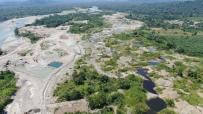
At first a tree like shihuahuaco inspires respect. It has lived at least one-thousand years to reach its height of 40 meters in height and its width of one and a half meters; a millennium in which it has had to evade human plunder while competing for nutrients with other trees and species of flora.
Its slow growth, typical of the hardest timbers in the forest, has allowed each specimen to capture up to 40 tons of carbon. If one considers that on average just one hectare of forest conserves 130 tons, one realizes how important the tree is for climate balance. It is also important for the harpy and the crested eagles (species considered vulnerable in Peru) that take advantage of the surging shihuahuaco canopy and the angle formed by its branches to build nests that will be reused in later seasons.
For decades both the legal and illicit timber industries viewed with interest the hardness of the shihuahuaco for the manufacturer of floors and structures. With just few days of work, the thousand years of the shihuahuaco vanish in a roar of chainsaws which do not stop until it has been turned into a giant pile of parquet boards.
Whilst the precise number of shihuahuacos cut down in recent years is not known, it is possible to make an estimate. A recent study by a group of scientists for the National Forest Service of Wild Fauna and Flora (Serfor) suggested that an average of 74 shihuahuacos per day had been logged over a period of 10 years. Simple maths tells us that the total of trees logged over the period would exceed 250 thousand logged trees.
Data like this has the scientific community on alert. But it is not enough. The shihuahuaco does not yet appear on the list of species of wild flora categorized as threatened, a list that had to be updated four years ago. Moreover, a new report obtained by Mongabay Latam now confirms that the species is critically endangered and warns that if the current rate of extraction rate is maintained, in two regions of the country it could disappear.
The unfinished list
Peru is home to two species of shihuahuaco: Dipteryx micrantha and, in smaller quantities, the Dipteryx charapilla, Although no single official inventory indicates its distribution across the country, modeling and projects from 2013 by the Supervisory Agency for Forest and Wildlife Resources (OSINFOR) established that it grows in Loreto, Ucayali, Madre de Dios, San Martín, Huánuco, Pasco and Junín.

Forest engineer Tatiana Espinosa conserves the species in her concession for the Arbio Peru conservation.
Credit: Gianella Espinosa / Arbio Perú.
It was the scarcity of knowledge about this species, and the boom in its extraction and export—especially to China—that led the National Forest Service of Wild Fauna and Flora (Serfor) to convene 99 Peruvian scientists in 2015 to update the official classification list of threatened wild flora species.
This group concluded that the shihuahuaco was one of 705 species of wild flora that should be placed in the list. The next step was the official publication of this document; the Forestry and Wildlife Law requires the list be updated every four years. It is twelve years since this last took place.
In an interview with Mongabay Latam the biologist Mirbel Epiquién, Serfor’s director of forest heritage sustainable management and wildlife in 2015, confirmed that the scientists and the classification methodology for the threat level for wild flora species were both determined by the agency. He noted it added climate change and species trade variables, among others, to the IUCN categories.
The scientists concluded that 61 species had to be classified as critically endangered, 87 as endangered, 239 as vulnerable, 256 as nearly threatened and 62 under the inadequate data classification. The shihuahuaco was one of 124 tree species were included in the list as being under threat due to “commercial pressure.”
“To get to that point we went through several data socialization meetings and sent the information to the Ministry of Agriculture in June 2016,” said Epiquién. The list was pre published three months later through Ministerial Resolution No. 0505-2016-MINAGRI together with the Draft Supreme Decree that would approve it. The objective was to receive opinions and suggestions within 20 working days.
Two years later the list remains unpublished. What has prevented its formalization?
Seeking answers, we attempted to meet with Alonso Rizo-Patrón, Serfor’s current Director of Forest Heritage Sustainable Management. He preferred to respond by email.
He wrote that “in 2016 there was a need to gather more information to support the published list and since then Serfor has been dedicated to this work in order to make a more appropriate categorization.”
Rizo-Patrón justified the delay by claiming that getting access to information was taking “more time than desired” and added that up until now the organization has been continuing to consult bibliographic sources and expert opinions. “We are confident that in the second half of this year we will be able to complete this process,” he wrote.
Along the way, a group of 75 Peruvian scientists sent a letter to the Ministry of Agriculture demanding that the Government comply with the updating and publication of the classification list of threatened wild flora species. They also expressed their concern about the shihuahuaco and requested that its conservation be assured. The scientists’ request fell on deaf ears.
Three years after this first attempt to protect 124 timber species, Mongabay Latam gained access to a new scientific report, prepared at the request of Serfor at the end of 2017. It paints a bleak picture for the shihuahuaco.
The latest diagnosis
The most recent chapter of this story took place in October of 2017, when a group of scientists, including botanists and biologists, was convened to once again prepare the classification of threatened wild flora species.
To obtain a clearer picture of the current status and the future of this species the experts used as a base the Serfor forest extraction yearbooks, and two OSINFOR reports: the figures about illegal logging, and the 2013 modeling of the distribution of the shihuahuaco to determine its probabilities of existence in the Peruvian forest.
The diagnosis yielded results more worrying than those of 2015. According to the classification sheet delivered to Serfor, the shihuahuaco is critically endangered—the IUCN’s most serious threat category.
The same record also shows that between 2000 and 2015 more than 2 million 994 thousand cubic meters of timber were extracted, that is, around 309,955 shihuahuaco trees of more than 55 centimeters in diameter. This calculation was made using the conversions and densities reported for the species in scientific research conducted in Loreto, Ucayali,and Madre de Dios.
The minimum cutting measure for this species is 51 centimeters, which means that the shihuahuacos were felled when they were between 250 and 300 years old. In addition, the report estimates that over a period of 10 years, an average of 74 trees were logged per day.
However, the study provides information that is even more relevant. Using the extraction figures from 2006 to 2015, the scientists were able to make a projection about what could happen with the shihuahuaco over the next ten years if the same extraction rate were maintained. They estimated that by 2025, 88% of the shihuahuaco trees would have be exhausted in Ucayali, and if Loreto and San Martín are considered together, the complete extraction of the species would be achieved, reaching 146%. In Madre de Dios, the reduction would reached 57% or even 100%, depending on the number of trees per hectare contained in the forest. In the rest of the country the removal would have reached 85%.

Scientific studies that have identified the slow growth of this species and enabled calculation of the number of trees that were felled between 2000 and 2015 based on the cubic meters obtained.
Credit: Classification record prepared by scientists for Serfor.
These figures are extrapolations and calculations from the few investigations that have been undertaken. Mongabay Latam contacted some of the scientists quoted in the report but none was willing to be interviewed.
Julia Urrunaga, Director of Peru Programs of the Environmental Investigation Agency (EIA), argues that although scientific studies indicate only a single species to be under threat, the state has duty to implement safeguards. “That there are insufficient studies does not preclude the state from acting until it obtains the data that guarantees the sustainability of the species,” he says.
Urrunaga is pointing to the precautionary principle contained in the General Law on Environment, which states that in the event of danger of serious or irreversible damage, “the lack of absolute certainty should not be used as a reason to postpone the adoption of effective and efficient measures to prevent its degradation.”
The biologist and ecologist Ernesto Ráez Luna points out that threat has twice been demonstrated by the scientific community. “In the event of a danger sign, you cannot choose to continue preying on the species and have its sustainability depend on what exists in protected natural areas,” he says.
Ráez Luna proposes a working table consisting of Serfor, the companies and a panel of experts that would develop a “corroboration methodology” for the state of the shishuahuaco to guarantee its preservation. The objective, says Ráez, would be to protect the shihuahuaco from suffering the same fate as cedar or mahogany, both of which are now scarce following heavy consumption in the past.
The timber sector’s account
The Association of Exporters (ADEX) has objected to the inclusion of forest species on the Serfor list. And also to the list prepared by the Convention on International Trade in Endangered Species of Wild Fauna and Flora (CITES), to which in 2016 there was an attempt to add the shihuahuaco. Erick Fischer, Vice President of the ADEX Timber and Timber Industries Committee claims that the shihuahuaco “is a long-lived species” with a “plentiful population Peru”. He also believes that “no forest species is really threatened by the industry.”
The ADEX representative points to “migratory agriculture and illegal logging” as the activities that plunder the forest. Fischer also quotes the report The Timber Industry in Peru prepared by the United Nations Food and Agriculture Organization (FAO[d1] ), which states that 50% of the timber trade in the country is illegal and 85% of the volume produced is destined for the national market.
Data from the consultancy Pro Expansión consultancy, quoted in the FAO report and also cited by Fischer, confirms that only 15% is for export. Fischer argues that this figure shows the impact of the forestry industry to be minimal and that inclusion of the species in CITES would only make the export process more bureaucratic.

In some forest concessions the timber is labeled for traceability. Verifying the timber origin is the main challenge facing Peruvian forestry and customs authorities.
Credit: Vanessa Romo / Mongabay Latam
Ernesto Ráez questions Fischer’s optimistic assessment about the state of the shihuahuaco. “It has not been possible to demonstrate that the extraction of this tree is taking place sustainably given that it is a long-lived species”, he says. “The shihuahuaco has had to live 250 to 300 years just to reach Peru’s minimum cutting size (51 centimeters). By that age, the tree has already produced new seeds, as claimed by logging companies. However, for these seeds to become trees that can be cut down again another three centuries is necessary and that not all young plants survive until that age.”
For Fischer, many ideas about the shihuahuaco need to be “demystified.” These include the dependence on the species of the harpy eagle. He claims that the eagle tends to rest on other dominant trees in areas where there are no shihuahuaco trees. “If it is not shihuahuaco it will be another species and if it finds a concrete pole that suits it, it will nest there,” he said.
“I would not object to their protection if the species were over-exploited; it would be a crime to oppose. However, the shihuahuaco is not vulnerable. If that were the case, we would be the first to say so,” says Fischer. He points out that this abundance is reflected in the forest management plans and annual operating plans provided by the logging companies and which require them to prepare a status report about the forest in their concession areas.

The scientists assessed the amount of total logging of shihuahuaco from 2000 to 2015 for each region. They used Serfor forestry yearbooks and information on illegal timber seizures from OSINFOR.
Credit: Classification record made by scientists for Serfor.
One more door that closed
The aforementioned CITES list represented one way to safeguard the shihuahuaco. But it fell short. At the end of April 2016, the national working group coordinated by the Ministry of the Environment that evaluates the proposals for inclusion on the list approved by consensus a request to add the shihuahuaco in appendix III. This would have forced any person or company interested in exporting the species to first obtain a certificate of origin and an export permit.
Despite the proposal sent to CITES indicating that the shihuahuaco’s inclusion on the list would ensure the legality of its trading and better monitoring of trade flows, together with a “better evaluation of the national state of gender”, this door was also closed
Ultimately, the shihuahuaco was not included on the list that Peru presented at the 2016 world meeting of CITES.

For the best logging, the annual cycle in forest concessions takes advantage of the drier months.
Credit: Vanessa Romo / Mongabay Latam
Consulted about the fate of that proposal, José Álvarez, who has returned to the MINAM Directorate of Biological Diversity, told Mongabay Latam that the CITES secretariat had said Peru first need to include the species on its national list of endangered wild flora .
This again highlighted the importance of Serfor updating the list.
Meanwhile, forest engineer Tatiana Espinoza wakes up every morning to the roar of the machines relentlessly processing timber in the Las Piedras basin in Madre de Dios.
Espinoza has led the Arbio Peru conservation project for eight years and tells us that her 916 hectares of forest is separated from the rest of the concessions processing timber by the Las Piedras River, where she sees boats transporting shihuahuaco on a daily basis.
“I try to connect with my thousand-year-old trees and this situation is difficult for me,” says Espinoza with the authority of someone who has estimated that her concession could house up to 600 shihuahuacos, specimens that have lived on average for 300 years. She also hopes, together with the majority of forest engineers, biologists and botanists who have studied and lived together with the shihuahuaco, that a solution is soon found on the road to its extinction.
 Tienes reportajes guardados
Tienes reportajes guardados















